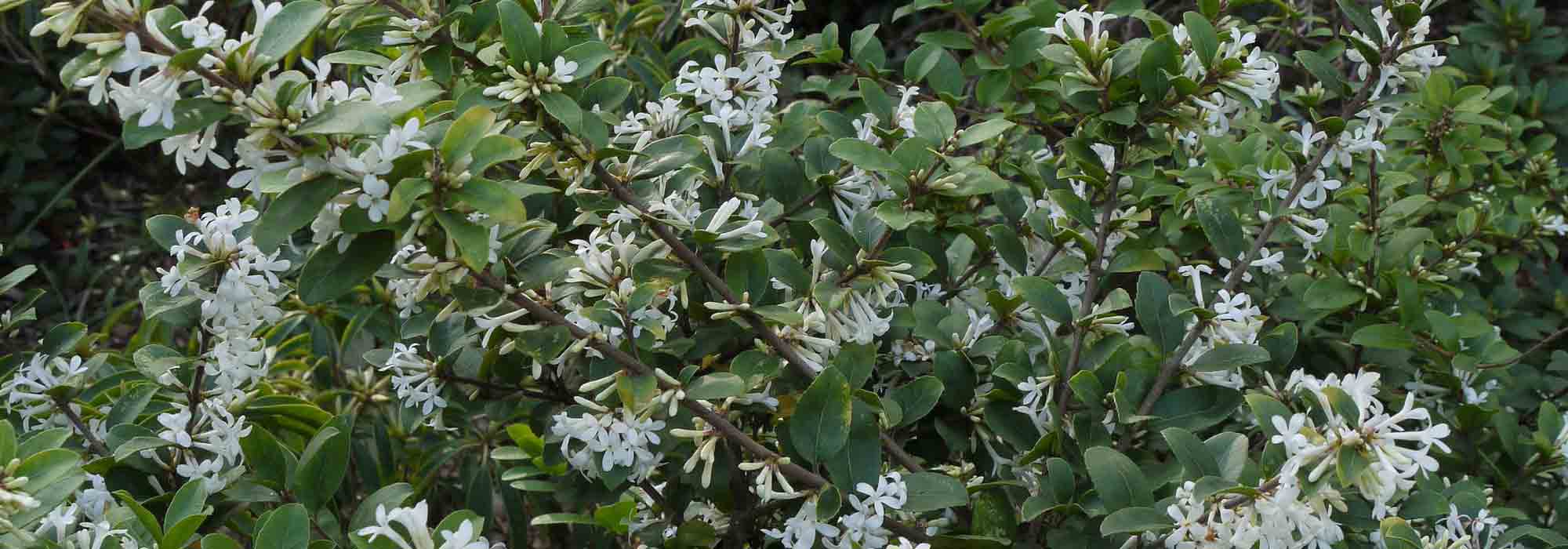
Osmanthus: planting, pruning and maintenance
Contents
Osmanthus in a nutshell
- Its spring or autumn white flowering exudes a lovely jasmine fragrance, making Osmanthus one of the most fragrant bushes in the garden
- Its glossy, smooth or spiky evergreen foliage in dark green or variegated is attractive all year round
- Quite hardy, it adapts to all regions, all types of soil and exposures, and is relatively resistant to diseases and pests
- It is one of the easiest bushes to grow in shade, even dry shade
- It is well-suited for creating beautiful low or medium-sized hedges that are both evergreen, fragrant, and defensive, as well as for borders and pot cultivation
A word from our expert
Evergreen foliage and fragrant white flowering, Osmanthus or Fragrant Olive, still too rarely planted in our gardens, is as easy to grow as box or holly in temperate regions.
Ideal for small gardens, it will thrive in a well-protected urban garden from cold winds as well as in the well-watered gardens of the coast or in a pot on a terrace.
From Osmanthus heterophyllus and its spiny variegated cultivar ‘tricolor’, to Osmanthus delavayi and Osmanthus x burkwoodii which flower in spring, through the highly fragrant Osmanthus fragrans, all are attractive all year round and announce their presence by filling the air with their beautiful jasmine-like fragrance in spring or autumn.
With its elegant foliage featuring more or less spiny leaves, it is well-suited for creating evergreen, fragrant, and even defensive hedges.
It is one of those low-maintenance shrubs that brings a lot of satisfaction to gardeners, even beginners, without much effort.
Plant it in ordinary soil, in all exposures, across all our regions! However, it will be much more beautiful in humus-bearing, light, and well-drained soil.
Discover through our collection of Osmanthus, this easy to grow shrub, which is not very sensitive to diseases and pests, and is essential for structuring beds and fragrant evergreen hedges.
Description and Botany
Botanical data
- Latin name Osmanthus
- Family Oleaceae
- Common name Osmanthus
- Flowering from April-May or from September to November
- Height 1 to 5 m
- Exposure Sun, partial shade
- Soil type All, well-drained
- Hardiness -10°C-15°C depending on varieties
The genus Osmanthus comprises around fifteen species of evergreen bushes or small trees belonging to the large and diverse family of Oleaceae, which includes the olive, lilac, and jasmines.
Native to the warm temperate mountain forests of Asia, the Pacific Islands, and the southern United States, Osmanthus or osmanthus is also evocatively known as “Fragrant Olive”, “Tea Olive”, or “Chinese Olive”. In our regions, it is best suited for temperate areas with mild winters.
Among the most common bushy species and varieties of osmanthus, we find Burkwood Osmanthus (Osmanthus x burkwoodi) and Osmanthus delavayi, which flower in spring, Osmanthus fragrans with its highly fragrant flowers, Osmanthus x fortunei, a vigorous hybrid, and Osmanthus heterophyllus, also known as false holly, with its cultivars featuring spiny foliage that flowers in autumn.
Slow-growing, the Osmanthus gradually forms a compact bush with multiple trunks and a very dense habit, often globose but sometimes upright. Some varieties do not exceed about 1 m in height, while others can exceed 5 m in height and the same in width.
This shrub with shiny evergreen foliage is attractive all year round. Its leaves exhibit variable appearance and coloration depending on the cultivars. The lanceolate, ovate leaves, arranged in opposite pairs, can be smooth-edged (Osmanthus burkwoodii) resembling those of laurel, slightly serrated (Osmanthus x fortunei), or bordered with very spiny teeth and deeply lobed resembling those of holly (Osmanthus heterophyllus).

Various foliage: Osmanthus heterophyllus ‘Tricolor’, Osmanthus heterophyllus ‘Gulftide’, Osmanthus heterophyllus ‘Purpureus’, Osmanthus heterophyllus ‘Goshiki’
Ranging from 1 to 20 cm long, leathery and glossy, they are dark green for the most part, sometimes edged in yellow or yellow.
Some osmanthus species exhibit changing foliage, with colours varying throughout the seasons, such as Osmanthus heterophyllus ‘Purpureus’ (or the variable-leaved osmanthus) with purplish foliage in its juvenile stage, then dark green with a slight purplish hue in summer, and Osmanthus heterophyllus ‘tricolor’ with spring leaves that are pink-orange, bright green then speckled with yellow in autumn.
Osmanthus is valued for its flowering with a delightful jasmine-like fragrance; it is one of the most fragrant blooms. In Greek, Osmanthus means “fragrant flowers”… On this elegant green foliage, whether uniform or variegated, the flowering occurs from late spring until frost, depending on the species, in successive waves. Early-flowering osmanthus bloom from April to May, while the later ones bloom from September to November.
Small tubular and waxy flowers measuring 2 mm to 1 cm in diameter, growing in small clusters, emerge in the axils of the leaves or in terminal panicles on this year’s shoots or on last year’s wood for early-flowering varieties. Composed of 4 rounded petals, they are most often white or cream, sometimes orange.
Edible, osmanthus flowers are harvested just before they fully open and can be preserved for a long time after drying.
They exude a heady fragrance that can be detected several metres away and resembles that of jasmine or gardenia, softened by fruity notes of apricot and peach. After distilling the flowers, osmanthus absolute (a concentrated extract) is used in the formulation of high-end perfumes and cosmetics.
Melliferous, after pollination by foraging insects, most osmanthus flowers give way to berries resembling small bluish-purple plums, sometimes frosted, measuring 0.5 to 2 cm long. The still-green fruits can be eaten like olives. These small berries will delight birds during the cold season. Osmanthus Burkwoodii, which is a hybrid form, rarely fruits.
Osmanthus is a hardy shrub (down to about -15°C), easy to grow in the ground in regions with a mild climate. It is a heat-loving plant and also tolerates coastal breezes very well.

The flowers of osmanthus are highly fragrant: Osmanthus burkwoodii, Osmanthus delavayi, Osmanthus heterophyllus ‘Gulftide’.
It grows in full sun or partial shade in any cool, fertile, well-drained soil, protected from cold, prevailing winds and severe frosts to safeguard its beautiful flowering.
It is used in fragrant beds in spring and summer, in country gardens, as a free hedge, in topiary, trained as isolated trees, as a windbreak or as a privacy screen in a pot on a partially shaded terrace close to the house to fully enjoy its fragrance.
It is the ideal shrub for a small enclosed garden!
Osmanthus flowers have been cultivated in China for over 2000 years and are used to flavour green tea, making them one of the ten traditional Chinese flowers.
In cooking, they are also used to flavour biscuits and syrups.
Main species and varieties
All Osmanthus are characterised by their beautiful evergreen foliage and intensely fragrant flowering in spring or autumn. Some compact varieties do not exceed 1 m in height, while the larger Osmanthus can reach 4 or 5 m.
The genus includes about fifteen species, with Burkwood Osmanthus (Osmanthus x burkwoodi), Osmanthus delavayi, Osmanthus x fortunei, Osmanthus heterophyllus, and Osmanthus fragrans being the most common, distinguished by their foliage, whether smooth or thorny, solid green or variegated, as well as by their size and flowering time.
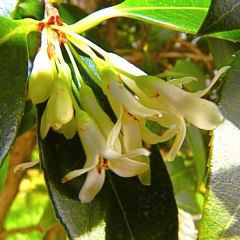
Osmanthus burkwoodii
- Flowering time May, June
- Height at maturity 3 m
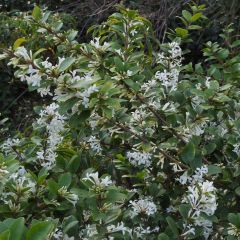
Osmanthus delavayi
- Flowering time May, June
- Height at maturity 3,50 m
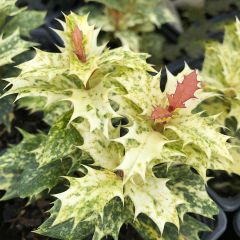
Osmanthus heterophyllus tricolor
- Flowering time October, November
- Height at maturity 1,50 m
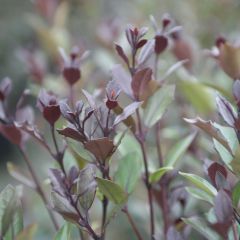
Osmanthus heterophyllus Purpureus
- Flowering time October, November
- Height at maturity 2,50 m
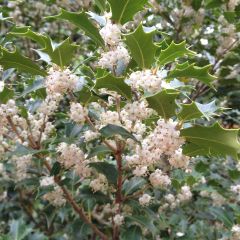
Osmanthus heterophyllus Gulftide
- Flowering time October, November
- Height at maturity 2 m
Discover other Osmanthus
View all →Available in 1 sizes
Available in 1 sizes
Available in 1 sizes
Available in 2 sizes
Available in 4 sizes
Available in 2 sizes
Available in 1 sizes
Available in 1 sizes
Available in 1 sizes
Available in 1 sizes
Young plantation
Where to plant Osmanthus?
Most Osmanthus are hardy throughout France, withstanding temperatures down to -10 to -12°C. However, this bush is sensitive to intense cold and icy winds that can compromise flowering by destroying some of the flower buds: a sheltered planting away from prevailing or cold winds and severe frosts will increase its hardiness. Beyond -12°C, its foliage may start to suffer; it is, however, capable of regrowing from the base. Some varieties, such as Osmanthus x burkwoodii, are hardier than others, while O. fragrans is the most frost-sensitive. So be cautious of severe frosts!
It has a clear preference for warm summers and mild, humid winters, and coastal climates suit it well. It will adapt very well to an oceanic climate and tolerates salt spray quite well. In regions with a mild climate, it will still withstand light, short-lived frosts in very well-drained soil and in a well-sheltered position from draughts. Elsewhere, it is preferable to grow the more frost-sensitive species in pots that can be moved indoors in winter to a conservatory or unheated greenhouse.
Osmanthus loves sunlight in cooler regions and will tolerate partial shade well south of the Loire. Plant it in a bed with light shade or exposed to the evening sun, protected from scorching sun that could damage its foliage and flower buds. It needs plenty of light to flower well.
Not very demanding, it accepts all light soils, except for very chalky ones, but it will be more floriferous in cool, well-drained, light loamy soil, deep and naturally rich. It fears poorly drained soils, and stagnant moisture that could rot its roots.
It does not tolerate an environment and soil that are too dry and appreciates regular watering in summer; however, once well-rooted, it is quite resistant to drought.
In the garden, ensure it has a well-ventilated location; under good conditions, larger osmanthus can reach a span of 3 to 5 m and should be allowed to develop freely.
Osmanthus is essential in a fragrant shrub bed, in a medium-sized evergreen hedge that is trimmed, free, or flowering with other flowering shrubs that bloom in spring or at staggered times. Larger osmanthus can be trained as solitary trees.
It effectively structures small spaces all year round. Perfectly tolerating pruning, the smaller compact varieties will form low hedges (Osmanthus x burkwoodii) or original topiaries.
The osmanthus heterophyllus with beautiful dentate and thorny foliage (‘Gulftide’) will advantageously replace holly in a defensive and fragrant hedge.
It can be planted under large deciduous trees that will naturally provide the shade and drainage it needs. It will thrive better protected by a wall or a hedge.
This delightfully fragrant bush deserves a special place in a pot on the terrace where it can perfectly serve as a windbreak or near the house by a frequently used path, filling the air with its jasmine-scented blooms.
When to plant Osmanthus?
While Osmanthus can be planted all year round, except during frost periods, a planting in spring as soon as the soil warms up is ideal. An autumn planting from September to November, after the heat has subsided, is also possible to encourage rooting before winter and to avoid repeated watering!
How to plant Osmanthus?
In the ground
If your soil is too heavy and clayey, lighten it with leaf compost and a bit of river sand or coarse gravel.
The Osmanthus placed in hedges should be spaced 70 cm to 1 m apart depending on their size at maturity. In beds, maintain a distance of 1 to 3 m depending on the varieties.
- Loosen the soil well
- Dig a hole at least three times wider than the root ball
- Backfill with the extracted soil mixed with sand, compost, or potting soil
- Keep the shrub upright, with the collar slightly below soil level
- Firm the soil
- Spread an organic mulch, especially in warm regions
- Water thoroughly, then once or twice a week to encourage recovery
Growing osmanthus in pots
This bush tolerates pot or container cultivation very well. Choose a large container with a depth of at least 40 cm.
- Spread clay balls at the bottom of the pot
- Plant it in a mixture of good soil, quality potting soil, sand, and compost
- Water once or twice a week during the growing season
- Place the pot in light but sheltered from scorching sun and draughts
→ Learn more about the cultivation of Osmanthus in pots in our advice sheet
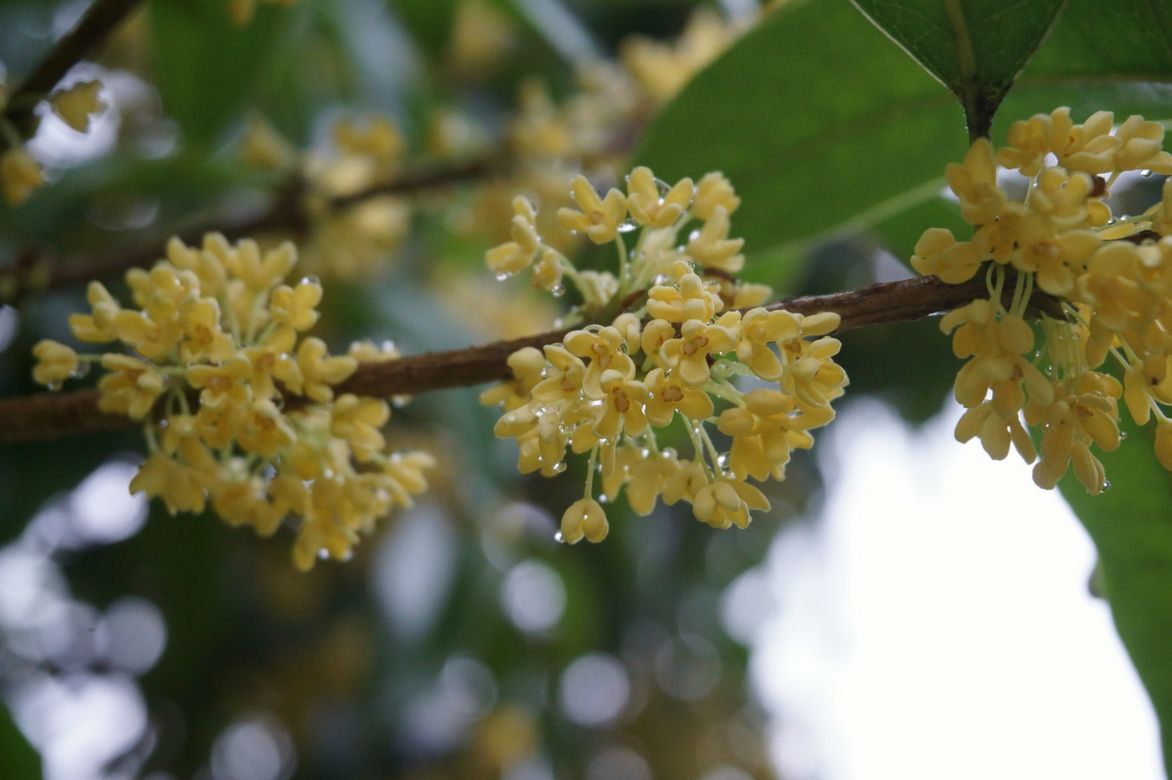
Flowers of Osmanthus fragrans
Maintenance, pruning and care
The Osmanthus is easy to grow, robust, rarely ill, and requires almost no maintenance once well established. This bush settles in slowly but surely, and will live for many years without particular requirements.
It appreciates regular watering: water once a week during growth without flooding the plant. After two summers, only water in case of prolonged drought.
To have beautiful flowers, incorporate each autumn one or two buckets of potting soil or compost by superficial scratching around the base.
Potted specimens can be fertilised during growth, with a liquid fertiliser once a month. Each year, perform a top dressing in spring with a potting soil mix.
Every year, in spring and autumn, spread a good layer of organic mulch (bark or pine needles, leaf litter) to keep its roots cool during the warm season and warm during winter.
The more frost-sensitive species of Osmanthus require small winter protection during the first years of cultivation, especially in cold regions. In case of a forecasted cold snap, cover the leaves of the most frost-sensitive varieties with a winter cover. In winter, space out watering and water every 10 to 20 days.
When and how to prune an Osmanthus?
Pruning Osmanthus is not essential but helps maintain dense foliage and a nice compact shape, encouraging the bush to thicken. Due to its slow growth, it is only done on well-established and well-branched specimens, after 3 to 4 years. All Osmanthus tolerate pruning, even severe, although this may affect flowering: they will only bloom again two years later.
Pruning is generally done after flowering at the end of winter before the vegetative resumption.
- For early flowering Osmanthus: In July, prune the stems compromising symmetry and the dead, thin or tangled stems. Remove dead shoots or branches damaged by frost.
- For late flowering Osmanthus: each year in February-March cut back by a third approximately the young shoots, cut the stems compromising symmetry. Remove faded flowers to avoid exhausting the bush and promote beautiful flowering the following year, unless you wish to obtain fruits.
Diseases and potential pests
The Osmanthus is well resistant to pollution and most diseases. Intense cold and excess water in winter are the main enemies of this bush, which can be quite sensitive and may be affected by grey rot.
However, it can rarely be subject to scale infestations: spraying with rapeseed oil will be sufficient to suffocate the unwanted pests.
Multiplication
The osmanthus is not easy to propagate. The two most common methods remain propagation by cuttings and layering. Cuttings are quite delicate to carry out, as they are done in a mini greenhouse with high humidity and require plant hormones and bottom heat to develop properly. We recommend layering by pegging, which is much less tedious.
- In autumn or spring, choose a sufficiently low and flexible stem
- Dig a furrow 10 cm deep in the soil near the base of the bush
- Remove all the lower leaves
- Incise the bark for about fifteen centimetres
- Arch the stem down to the ground and bury the incised part 2 to 3 cm deep
- Raise the leafy end of the branch and stake this aerial part
- Fill in the furrow and secure the layer with a hook or a stone
- Water regularly
- The buds root in 1 year: in the following spring or autumn, cut the stem at the point where it enters the soil to wean the layer
- With a spade, dig up the new plant
- Transplant immediately into open ground and water
Associating Osmanthus with the Garden
With its abundant flowering with an extremely pleasant jasmine-like fragrance and beautiful glossy foliage, Osmanthus will always add a striking presence to the garden. Its elegant silhouette will fit beautifully into a English-style garden, a country garden, or simply in a romantic garden or chic and timeless setting.
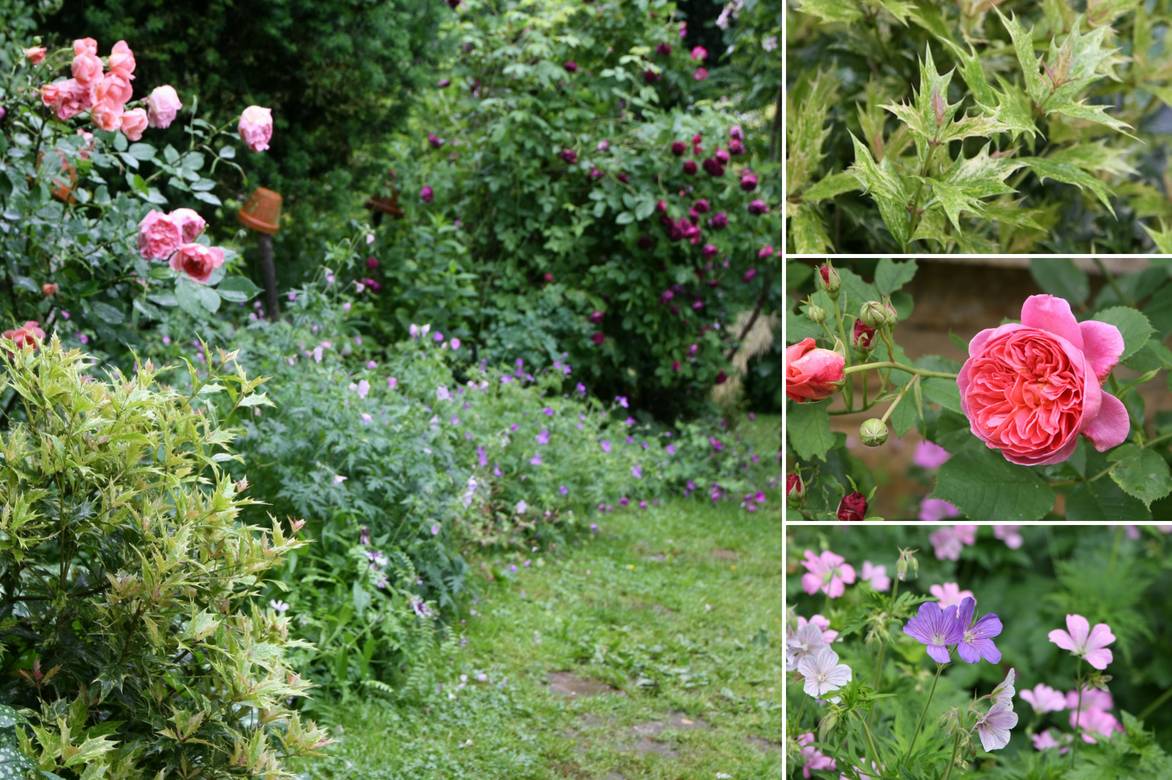
A pairing idea: Osmanthus heterophyllus ‘Tricolor’, Rose ‘Boscobel’, hardy geraniums (Photos Virginie Douce).
The white flowering of Osmanthus makes this bush an exceptional subject in a white garden alongside old roses, lilacs, a Garrya elliptica, spring spiraea, Hellebores, Vinca minor, Bleeding Heart, winter and summer heathers, ornamental tobacco, and late white tulip bulbs or Japanese Anemones, with which it creates fresh and romantic scenes.
In a shrub border, it will pair well with winter-flowering shrubs such as Korean white Forsythia, Witch Hazel, Sarcococca, another evergreen that delights with its deliciously fragrant flowers.
Osmanthus integrates easily into summer borders in partial shade alongside Hibiscus syriacus, white Buddleias, Hydrangea macrophylla, Elaeagnus, or a Mahonia.
In a magnificent evergreen hedge requiring little maintenance and marking the seasons with their changing colours, Osmanthus will shine alongside other evergreen shrubs such as photinias, Pieris, Japanese Azaleas, and a laurel-tin.

A persistent pairing idea: Photinia fraseri ‘Pink Marble’, Osmanthus delavayi, Azalea japonica ‘Kirin’, Pieris japonica ‘Forest Flame’, Viburnum tinus ‘Spirit’.
In a defensive hedge, spiny-leaved Osmanthus (Osmanthus heterophyllus) will be ideal companions for Holly and white-flowered currant or false blackcurrant.
At the end of the season, its decorative blue-black berries will pair well with those of an Aucuba Japonica Variegata, Sacred Bambus, Berberis, and Callicarpa.
Useful resources
- Which bush to accompany your Osmanthus in a hedge? Discover all our evergreen bushes!
- A wealth of inspiring ideas on our blog to find the bush you need!
- City garden, small garden or country garden, Osmanthus lends itself to all inspirations!
- Our video: Osmanthus heterophyllus
- Subscribe!
- Contents
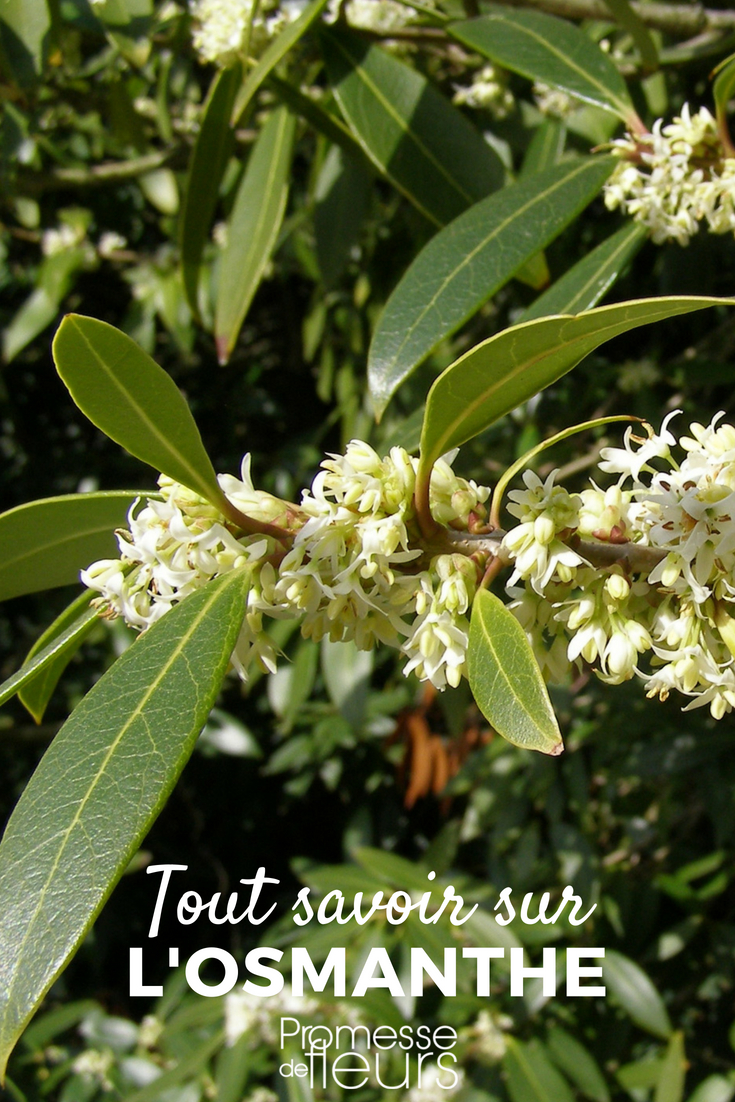































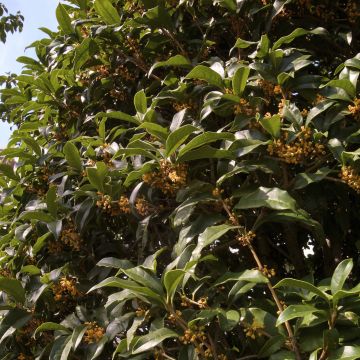
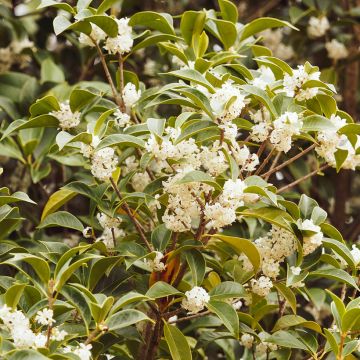




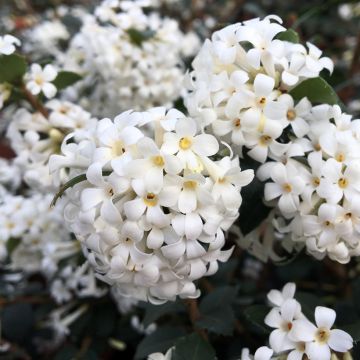
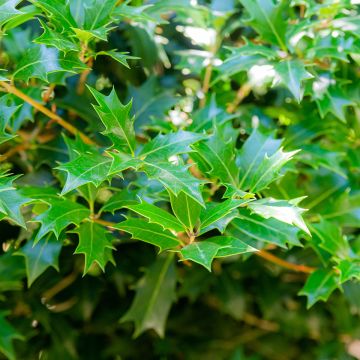
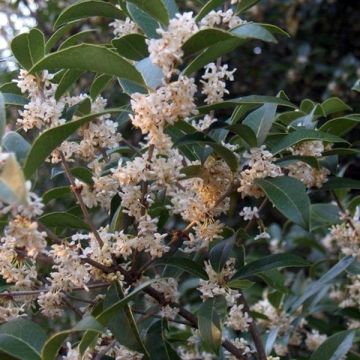
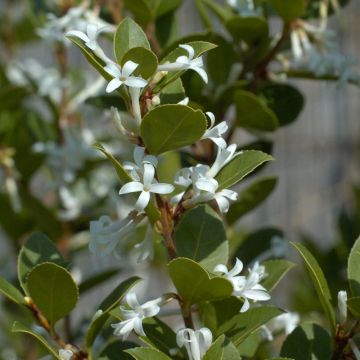
Comments